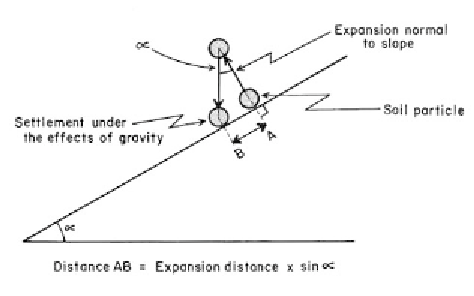Geoscience Reference
In-Depth Information
The most efficient way to reduce damage caused by
expansive soils is to avoid them. In Australia, however,
this is almost impossible. Other methods to minimize
damage include removing the expanding soil (especially
at the surface); applying heavy loads to the surface;
preventing water access to the site; pre-wetting the soil
and preventing its drying out forever afterwards
(although damp soil attracts termites); or ensuring that
foundations are sunk deep enough to minimize the
effects of near-surface swelling and shrinking. It is also
possible to change the ionic character of the soil by
adding hydrated lime, Ca(OH)
2
, to the surface of an
expanding clay. The lime lowers the exchange capacity
of the clay. Water, thus, cannot be substituted into the
internal lattice structure of this clay mineral as effi-
ciently, and expansion is reduced. Note that the addition
of lime to a soil subject to cracking is not recommended,
if that soil is also quick clay. Liming dramatically
decreases this latter soil's cohesiveness.
seasonal inequalities in rainfall. The process can also be
accomplished by freezing and thawing of water in the
soil, and by salt crystallization. Each time expansion
happens, the soil tends to be pushed upward at right
angles to the slope (Figure 12.9). This process weakens
the coherence of the soil mass. When shrinkage or
thawing eventuates, the soil settles back to its original
position; however, gravity will tend to move the material
slightly downslope. Creep rates should be proportional
to the tangent of the angle of the slope, and all material
should move downslope. In practice, it has been found
that the rates of movement on a constant slope can
vary greatly over small distances, to the point of being
random. There are also measurements indicating that
creep movement can occur upslope. This result implies
that expansion and contraction do not operate normal
to the slope. In this regard, a slope must be considered
three-dimensional, with movement possible in any
direction including upslope and laterally. This aspect
has already been recognized in periglacial environ-
ments, where lateral sorting of sediment dominates
the micro-morphological evolution of the landscape. In
environments where a distinct thawing season exists
after the soil has been frozen, or where rainfall is
seasonal, creep rates will vary seasonally. The process is
fastest in spring, when temperatures are still cool
enough for the ground to re-freeze at night, and during
the wet season, when distinct seasonal inequalities in
rainfall exist.
Creep in clay does not always depend upon expansion
and contraction. If clay is wet enough to become plastic,
it will deform under load in the downslope direction. As
the rate of creep depends upon the weight of over-
burden, deformation may occur only at depth in the
profile and not at the surface. Creep, in clays at depth
Cree
p and solifluction
(Leopold et al., 1964; Sharpe, 1968; Young, 1972;
Finlayson & Statham, 1980)
Under sustained shearing stresses, all soil and rock
materials on slopes exhibit viscous behavior, which is
termed creep. Where the melting of ground ice exacer-
bates the movement, the process is termed solifluction.
Rates of creep are not substantial and rarely exceed
1-2 mm yr
-1
, although velocities over 100 mm yr
-1
have
been measured on slopes as steep as 40°. Because creep
is more active towards the surface of a soil profile, the
rate of movement and the resulting displacement
decrease with depth. This is partly due to compaction
and increased loading at depth. If material has some
long-term instability, shearing planes or surfaces will
develop in the region of maximum shear stress. This
point usually occurs at the base of the soil profile
between the B and C horizons, or along fractures
(bedding planes) in the underlying weathered bedrock.
A stone line, above which banding in the soil occurs,
and below which imperceptible movement takes place,
often shows this. Material in this zone will shear until its
strength is reached. If further shearing eventuates
upward in the profile, the displacement becomes
cumulative and, hence, greatest towards the surface.
Creeping of a regolith downslope can also be accom-
plished by alternating expansion and shrinking of a soil.
The most obvious mechanism for this process is the
presence of expanding clays under the influence of
Expansion normal
to slope
α
x
Soil particle
Settlement under
the effects of gravity
α
Distance AB = Expansion distance = x tan
α
Mechanism for the downhill movement caused by soil
creep of material on a slope.
Fig. 12.9














